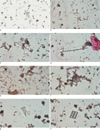Abstract
The acid digestion method for extracting diatoms has been widely used to confirm death by drowning, but its reliability is still disputed because some diatoms can be destroyed during the extraction process due to treatment with strong acid and heat. There is a need to develop an efficient and reliable digestive method to overcome the limitation of the present analytical procedure. In this study, the reliability and efficacy of quantitative and qualitative diatom analysis from seawater by an enzymatic digestion method was evaluated. We confirmed the merit of the enzymatic method that used proteinase K instead of nitric acid in the conventional method. As a result, the enzymatic method showed a higher recovery ratio and better preservation of the diatom structure, which is essential for quantitative (diatom density) and qualitative (species) interpretation of diatom analysis. This result indicates that the enzymatic method can replace the conventional acid digestion method to confirm cases of death by drowning since it is more reliable and yields conclusive results.
Figures and Tables
 | Fig. 1Dominant species of plankton digested by proteinase-K are presented (400×).
a, b: Nitzschia, c: Pleurosigma, d: Synedra, e: Cocconeis, f: Coscinodiscus, g: Licmophora, h: Grammatophora
|
 | Fig. 2The plankton features in detail show significant difference between acid digestion and enzyme digestion (400 ×).
a, a': Nitzschia, b, b': Grammatophora, c, c': Pleurosigma
|
References
1. Cox EJ, Willis L, Bentley K. Integrated simulation with experimentation is a powerful tool for understanding diatom valve morphogenesis. BioSystems. 2012. 109:450–459.
2. Piette MHA, De Letter EA. Drowning: Still a difficult autopsy diagnosis. Forensic Sci Int. 2006. 163:1–9.
3. Ludes B, Quantin S, Coste M, Mangin P. Application of a simple enzymatic digestion method for diatom detection in the diagnosis of drowning in putrified corpses by diatom analysis. Int J Legal Med. 1994. 107:37–41.
4. Peabody AJ. Diatoms and drowning - a review. Med Sci Law. 1980. 20:254–261.
5. Foged N. Diatoms and Drowning - Once More. Forensic Sci Int. 1983. 21:153–159.
6. Ming M, Meng X, Wang E. Evaluation of four digestive methods for extracting diatoms. Forensic Sci Int. 2007. 170:29–34.
7. DiGiancamillo A, Domeneghini C, Gibelli D, Cattaneo C. Diatom extraction with HCl from animal tissues: A technical note. Leg Med (Tokyo). 2011. 13:268–271.
8. Auer A. Qualitative diatom analysis as a tool to diagnose drowning. Am J Forensic Med Pathol. 1991. 12:213–218.
9. Ludes B, Coste M, Tracqui A, Mangin P. Continuous river monitoring of the diatoms in the diagnosis of drowning. J Forensic Sci. 1996. 41:425–428.




 PDF
PDF ePub
ePub Citation
Citation Print
Print




 XML Download
XML Download